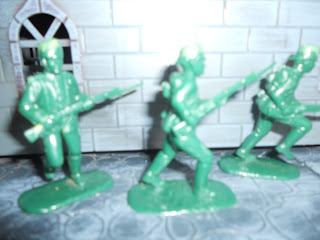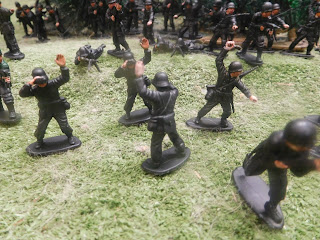First And Second Books Of Wargaming Ordered And The Inspiration Of Invented Countries
These are certainly among my favorite books, and I have reviewed them before. I won new copies on Ebay and I am awaiting their delivery from America. A First Book of Wargaming and A Second Book Of Wargaming I discovered in the late 70s or early 80s. That coincided with me discovering other 54mm collectors and wargamers through Plastic Warrior magazine and the Australian collectors group, ACOTS. I did not have to abandon my 1/32 toy soldiers for 'serious' 20 or 25mm wargaming figures. Not that my wargames have ever become totally serious.
My copy of The Second Book Of Wargaming has been missing some time although I still have a photocopied version. Where did that go? My copy of A First Book of Wargaming I still have, although it is in worse condition than the one, I have just bought.
The author Frank Perry and his son Ross and friend Ken are people I would very much like to have met as their wargaming projects inspired so much of my imagination with fantasy armies based on invented countries. Although the predominant pictures in the books indicate a preoccupation with WW1 and WW2 armies Frank actually used figures and armies from a range of periods, often in the same games. That is because his fictitious countries of Caspia had different levels of development. This is not really discussed in these books but featured in some old plastic Warrior articles. An ancient Egyptian army might fight a modern one but the ancient commander would have to be very adaptable.
My friend Mat and I have played various combinations of historical and fantasy armies. Our most recent games were a Doctor Who and UNIT versus Daleks game and a garden wargame of Lionia (Abyssinia) versus Redia (Britain) circa 1900.
I am currently planning out our next fantasy campaign as my country of Beerstein and Mat's Bogavania and Fezia enter a level of 18th century technology. Mat's armies will fight Aztecia (Aztecs and dinosaurs) and I'll be fighting the cursed Undead complete with its vampires, zombies, skeleton warriors and assorted monsters. Although we are entering a level of musketry and better cannons, I think some of my forces and heroes will retain armor to protect against those Undead nasties. A few magic swords would not go amiss either.
The main downer at the moment is I don't have a means of taking photos as I am still awaiting my camera purchase from America through Ebay.











Great books, enjoy. Hope the camera arrives quickly.
ReplyDeleteAlan Tradgardland
Thanks. Yes, I can get Mat to take pics for me if necessary. I will be mostly clearing stuff away from tables next few days.
ReplyDeleteThose looks like really interesting books. Are the rules easy to play and good??
ReplyDeleteThe rules are not difficult. However, I never used the complete rules but just got ideas that I have or might incorporate. It has interesting rules for weather, gas warfare and amphibious landings.
ReplyDeleteI like the books just for the photos alone. If you go to search, on my blog you will find my older posts on frank's books and wargames.
The most interesting things I found about Frank Perry's games was in the Plastic Warrior books and not mentioned in these books. That is that the generals and commanders have particular personalities that the players are meant to play by, for example cautious, reckless etc. I found it a bit hard to deliberately do stupid moves in a game. Mat and I deal wit this by using percentage dice to work out just to what degree a commander is cautious, reckless etc and then roll a dice to see if the player can carry on as normal. A cautious commander might not be able to advance towards an enemy until a certain dice roll is made. A reckless one has to roll a dice to see if he does not attack a superior enemy. I take this further by having a 'kindness' rating. A cruel commander might execute prisoners, burn down villages etc. Also, the most important one we use is 'battlefield intelligence' so a commander with a high level can make the other side reroll dice to see who sets up first or moves first. But those are my own rules that are an extension of what I read in the articles as I wanted actual mechanisms. I also have religiosity, character's ages etc.
As for Frank's basic rules they are extensions of the H.G. Wells rules but adapted to include machineguns, grenades etc.
One approach to tailoring command behaviour to the type f general might be to list, say, 3 possible courses of action, one bold/rash, one 'common sensical' and another cautious/ timid. But weight the rolls. You could weight the rolls for a rash commander by 1-3 does to rash thing; 4-5 the sensible; 1 the cautious. An able commander you might weight towards the 'common sense' - 1. Bold move, 2-5 sensible move, 6 = cautious.
ReplyDeleteIt might be worth considering, though, that bold not not equal rash; nor does cautious equal timid. At any rate, character is not always consistent. Imagine: a fire-eater like Marshal Ney was at his best commanding a rearguard. The same could be said of Prince Bagration.
Cheers,
Ion
Very sensible!
DeleteFabulous books - and very much in the sprit of the games we both play now.
ReplyDeleteYes, it is the aesthetic that I like. I never really played board wargames because I like moving around mostly 54mm figures on a table.
Delete